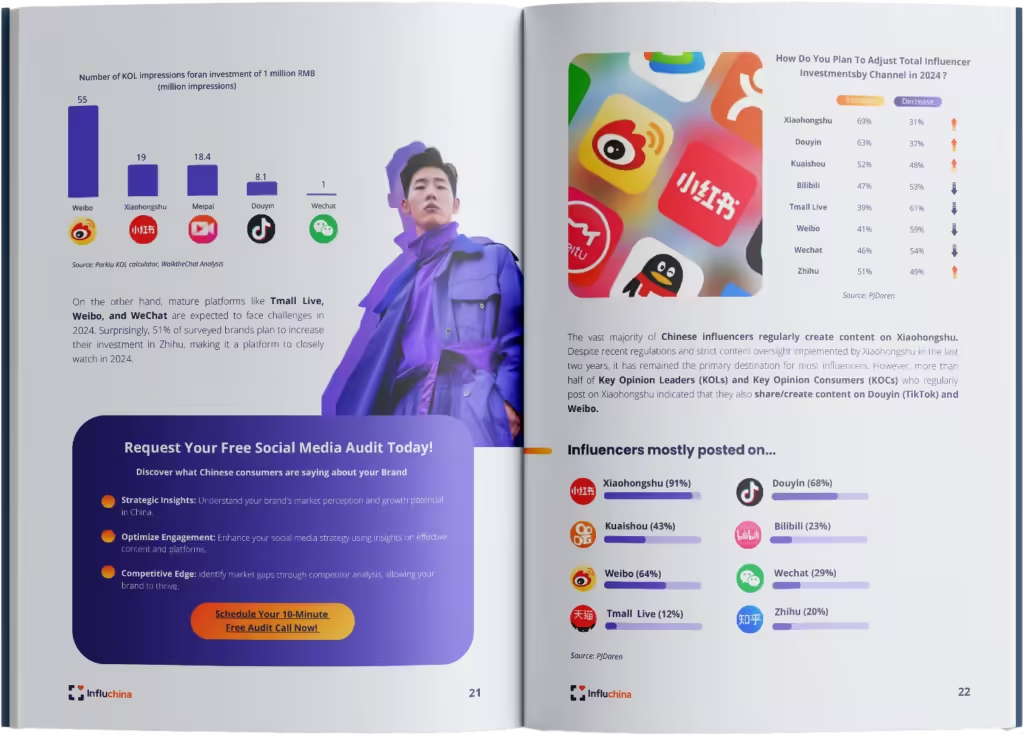TL;DR | Chinese Influencer Marketing in China (2025 Guide)
Influencer marketing in China combines cultural understanding, local platforms, and authentic storytelling. Success comes from balancing visibility (KOLs) and credibility (KOCs) through localized, compliant, and measurable campaigns.
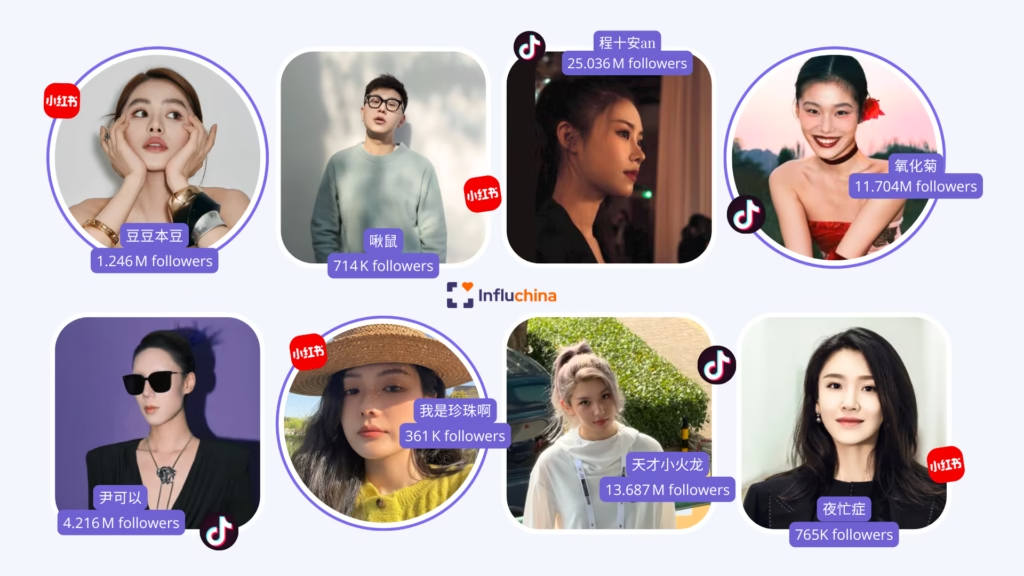
Starting influencer marketing in China can feel like entering a completely new digital ecosystem — and in many ways, it is.
With over 1.2 billion active social media users, China has the world’s largest and most dynamic influencer market. Platforms like Douyin and Xiaohongshu redefine how consumers discover products, engage with brands, and make purchases.
For global brands, this represents a massive opportunity — but success requires more than translation or copying Western strategies. Chinese social platforms run on unique algorithms, local culture, and trust-based influencer ecosystems.
This complete guide explains how influencer marketing works in China, the platforms that matter most, the role of KOLs and KOCs, campaign setup steps, legal considerations, and how to build a data-driven strategy that achieves real results in the Chinese market.
What Is Influencer Marketing in China?
Influencer marketing in China have become an essential tool in digital marketing and advertising. Better known in China as KOLs (Key Opinion Leaders), people with a large number of followers on social networks such as Little Red Book (chinese version of Instagram), Douyin (Chinese TikTok), WeChat, Kuaishou, Toutiao and Weibo.
KOLs (Key Opinion Leaders) in China are people with large numbers of followers on social networks such as Little Red Book (Chinese Instagram), Douyin (Chinese TikTok) or WeChat
In addition, Chinese social influencers have great sway in the opinion of their audience, which makes them a key element for brands looking to promote their products and services.
Chinese influencers are considered professionals on social media in China, as they know how to stand out, in addition to having a great ability to promote and sell products effectively.
Their success is the result of the sum of their interesting personalities and their extensive knowledge of Chinese social media. Moreover, Chinese consumers rely heavily on recommendations from people they follow on social media, underscoring the importance of understanding this market.
74% of Chinese consumers make purchasing decisions based on influencers' recommendations, compared to only 30% in the rest of the world
1. Why Influencer Marketing Works in China (Key Advantages Explained)
Collaboration with top influencers in China has become a key strategy in the digital marketing world to reach consumers. For brands entering the Chinese market, the use of Key Opinion Leaders (KOLs) plays an even more crucial role, largely due to the unique characteristics of the Chinese market. Incorporating KOLs into your China marketing strategy can offer numerous benefits. Some of the most significant advantages include:
1.1 Direct Access to a Massive Consumer Base
China’s population exceeds 1.4 billion, with over 1 billion internet users actively engaging on social media platforms. Influencers offer an effective way to connect with this massive audience, particularly when focusing on specific groups such as Gen Z, millennials, or affluent urban consumers. Major platforms like Douyin and Xiaohongshu, with their millions of daily active users, provide unparalleled opportunities for influencer campaigns to achieve significant visibility and engagement.
1.2 High Levels of Consumer Trust
Chinese consumers often place significant trust in recommendations from Key Opinion Leaders (KOLs) and Key Opinion Consumers (KOCs) when deciding what to buy. Unlike traditional advertising, influencer content is perceived as authentic and personal, creating a sense of trust that motivates consumers to engage more deeply with brands.
For example, a Douyin influencer’s product demonstration can generate significantly higher purchase intent compared to generic advertisements, showcasing the power of influencer marketing in building consumer confidence and driving conversions.
1.3 Amplified Sales Through Livestreaming
Livestreaming has become a cornerstone of e-commerce in China, with influencers taking center stage in this dynamic market.
China streaming platforms, such as Taobao Live, enable influencers to showcase products in real-time, creating a sense of urgency that encourages immediate purchases and significantly boosts sales. The impact is undeniable—top influencers have proven their ability to generate millions in sales during a single livestream, demonstrating the unparalleled power of this format in driving consumer engagement and revenue.
1.4 Enhanced Cultural Relevance
Influencers play a crucial role in helping brands adapt their messages to the Chinese market, ensuring they resonate with local values, traditions, and consumer preferences.
For foreign brands looking to enter the Chinese market, influencers provide an essential bridge to connect with local audiences. Their deep understanding of cultural nuances allows them to tailor content in a way that feels authentic and relatable, minimizing the risk of cultural missteps. This localized approach can be the defining factor between a campaign that connects meaningfully with Chinese consumers and one that fails to make an impact.
Influencers play a crucial role in helping brands adapt their messages to the Chinese market, ensuring they resonate with local values, traditions, and consumer preferences.
1.5 Seamless Integration with E-Commerce
Seamless Integration with E-Commerce is one of the key advantages of working with influencers in China. Many Chinese influencers incorporate direct links to e-commerce platforms, streamlining the buyer journey and enhancing the overall experience of e-commerce in China. Platforms like WeChat mini programs and Douyin shops allow consumers to explore and purchase products without leaving the influencer’s content. This seamless approach not only reduces friction in the shopping process but also leads to higher conversion rates.
Partnering with a China e-commerce agency can further enhance this process by ensuring the right platform integrations, optimizing product listings, and aligning influencer campaigns with effective sales strategies. This seamless approach not only reduces friction in the shopping process but also leads to higher conversion rates. By merging entertainment with commerce, influencers create a frictionless shopping experience that drives substantial sales in the rapidly growing landscape of e-commerce in China.
2. Which Social Media Platforms to Choose for Influencer Marketing in China
In China’s highly digital, mobile-first society, influencers—known as KOLs (Key Opinion Leaders) and KOCs (Key Opinion Consumers)—shape how people discover, evaluate, and purchase products. Unlike in many Western markets where users rely on Google reviews or YouTube tutorials, Chinese consumers often make buying decisions directly on social media platforms through influencers they trust.
Platforms like Douyin, Xiaohongshu (RED), Weibo, WeChat, Bilibili, and Kuaishou have redefined how brands build awareness and drive conversions. Each serves a different purpose, audience, and content style. Choosing the right platform depends largely on your industry, goals, and target demographics.
Below is an overview of how each major sector connects with the most relevant Chinese platforms:
Beauty & Skincare – Xiaohongshu (Rednote) and Douyin
Beauty brands thrive on authenticity and visible results, making Xiaohongshu and Douyin the top choices.
Xiaohongshu (RED): The go-to platform for Gen Z and millennial women searching for trusted reviews, tutorials, and before-and-after comparisons.
Douyin: Livestreams and short videos drive impulse purchases, particularly during shopping festivals like Double 11 or 618.
Influencer marketing here focuses on product credibility, social proof, and viral visibility — essential for building brand trust quickly.
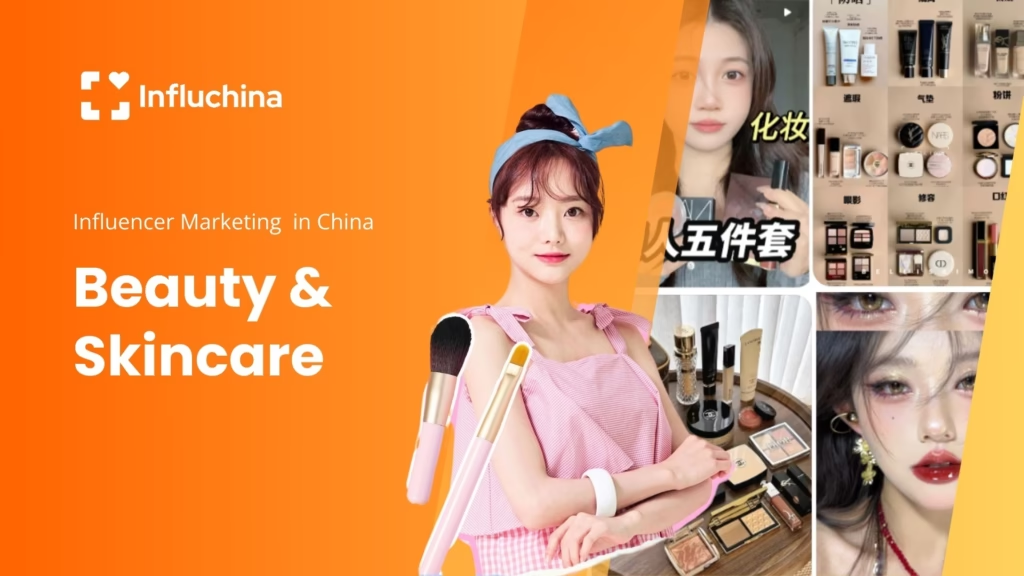
Fashion & Lifestyle – Xiaohongshu, Douyin, and Weibo
Trends in China move fast, and fashion influencers are the ultimate style authorities.
Xiaohongshu: Ideal for aspirational yet relatable content — users seek outfit inspiration and daily looks.
Douyin: Drives fast conversions with short, trendy styling videos.
Weibo: Amplifies visibility through hashtag challenges and celebrity collaborations, helping brands go viral across large audiences.
These platforms help localize your aesthetic, build community identity, and generate demand in real time.
Learn more about fashion and luxury marketing in China in this article.

Food & Beverage (F&B) – Douyin, Xiaohongshu, and Kuaishou
Food is one of the most social verticals in China, and influencer storytelling drives both online orders and offline visits.
Douyin: Viral restaurant reviews and “food challenge” videos dominate.
Xiaohongshu: Niche KOCs share recipes and dining experiences that reinforce authenticity.
Kuaishou: Popular in lower-tier cities, it’s ideal for snack, beverage, and mass-market food brands targeting regional audiences.
Influencer campaigns here build trust, appetite appeal, and UGC (user-generated content) that fuels organic growth.

Health, Wellness & Supplements – Xiaohongshu and WeChat
Health-conscious consumers rely on creators who share personal journeys and transparent insights.
Xiaohongshu: A trusted platform for wellness advice, product comparisons, and ingredient analysis.
WeChat: Ideal for deeper storytelling through Official Accounts and Mini Programs that retain loyal customers over time.
Campaigns in this category build long-term credibility and loyal community engagement.

Travel, Hospitality & Experiences – Douyin, Xiaohongshu, and Weibo
Travel decisions in China are increasingly driven by influencers’ itineraries and hotel reviews.
Douyin: Engaging travel vlogs and livestream hotel tours spark immediate interest.
Xiaohongshu: Acts as a visual travel guide for millennials planning domestic or outbound trips.
Weibo: Boosts destination visibility through collaborations with travel KOLs and branded hashtag challenges.
💡 According to Turespaña, 74% of Chinese tourists choose destinations based on recommendations seen on social media—compared to just 30% globally—making influencer presence essential in tourism marketing.
Tech & Consumer Electronics – Bilibili and Douyin
Chinese consumers trust influencers who test and compare products live.
Bilibili: Best for long-form content such as product demos, reviews, and setup tutorials.
Douyin: Delivers shorter, engaging tech explainers that blend entertainment with education.
For tech brands, influencer marketing focuses on authenticity, reliability, and educational storytelling that simplifies complex features.
Want to dive deeper into influencer marketing in China?
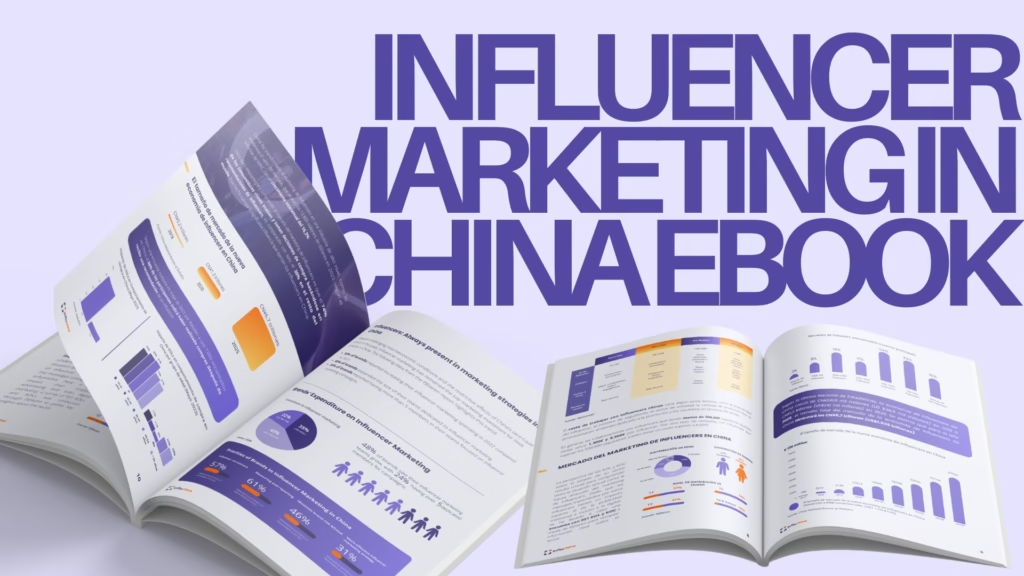
Download our free eBook on influencer marketing in China—packed with platform insights, campaign tips, and real examples to help you get started with confidence.
3. How to Start an Influencer Campaign in China?
In an industry as vast as the Chinese market, it is essential to have the right tools to find the best Chinese influencers to promote your brand.
Before implementing an influencer marketing strategy, you need to take into account several aspects:
- Define Your Campaign Objectives
- Determine the budget.
- Choose the Right Type of Influencer (KOL or KOC).
- Select the Right Platforms.
- Other relevant factors.
When planning a campaign, it’s essential to recognize the significance of Chinese social media. Collaborating with multiple Chinese influencers across different platforms is one of the most effective strategies to promote your products or services and successfully attract a larger Chinese audience.
Collaborating with multiple Chinese influencers across different platforms is one of the most effective strategies to promote your products or services and successfully attract a larger Chinese audience.

Our agency, specializing in KOL marketing in China, is dedicated to helping brands boost their online sales and visibility by forming strategic collaborations with the right Chinese influencers.
Step 1: Define Your Campaign Objective for China
When planning a campaign, it’s essential to go beyond budget considerations and focus on defining clear objectives to ensure its success. These objectives typically include:
- Brand Awareness: Increasing visibility and recognition of the brand.
- Sales: Driving conversions and boosting revenue.
- Reach: Expanding your audience and targeting new customer segments.
- Interactions: Encouraging engagement and fostering a deeper connection with the audience.
Another key factor is identifying the geographic areas you aim to cover, such as Tier 1, Tier 2, Tier 3, or Tier 4 cities. This decision should align with the demographic segment you want to target, based on the nature of your brand or product offering.
By aligning your campaign objectives with specific geographic and demographic targets, you can build a more tailored strategy that maximizes impact and ensures better results.
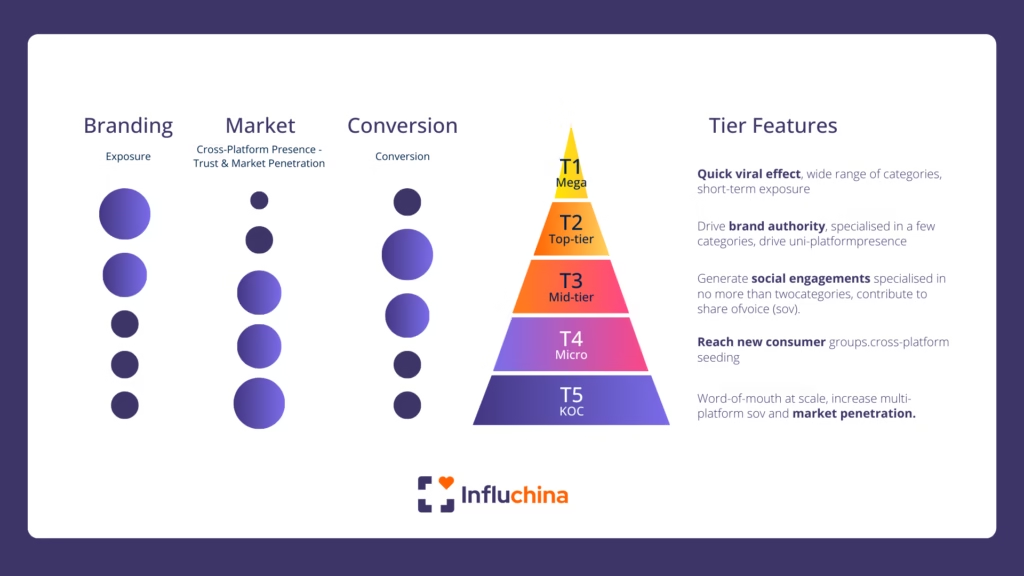
If you want to learn more about defining campaign objectives and strategies, be sure to check out our China Influencer Marketing Insights Report for in-depth guidance and valuable insights.
Step 2: Determine Your Influencer Marketing Budget
At this point of the strategy, it is important to know that prices vary, depending on whether the influencers are located in highly developed areas of China or not. Another factor is what is required of the influencer, since the costs are not the same for a video as for a simple post
Top influencers in China also value the client’s requirements, such as: number of times the product appears, product orientation in the content (plans, appearance), the period in which they collaborate (Chinese holiday dates are usually less economical than periods without holidays), number of collaborations, reposts on social media, the Influencer’s commissions, etc.
It should be noted that some Chinese social influencers may charge higher rates for brands that are not yet very popular in China.
It is critical to have a clear idea of the budget needed to determine which types of Chinese influencers to hire.
Step 3: Choose the Right Type of Chinese Influencer (KOL or KOC)
Choosing the type of influencer depends on the available budget. To plan the number of collaborations, it is essential to distribute the budget as effectively as possible. To do this, you need to know the types of Chinese influencers.
Depending on the budget, you will be able to access different types of Chinese influencers, which are divided according to impact, size and social networks.
Selecting Influencers by Size and Impact
Depending on the influencer’s impact and audience, we can categorize into two types:
KOL (Key Opinion Leader)
KOLs, as we have seen, have become increasingly important in the marketing strategies of those who wish to break into the Chinese market. KOLs are celebrities, writers, and social media celebrities who are considered experts in a certain field or topic, so their advice is perceived as genuine and unbiased.
-KOC (Key Opinion Consumer)
KOCs are consumers who personally promote products through reviews. These individuals tend to be much more selective in what they are willing to recommend and share as safe information, so their reviews are much more similar to advice among friends than user-generated content.
KOCs are key to users making a purchase decision because they are generally considered more trustworthy due to their authentic content.
How are Chinese Influencers Categorized by Size?
In China’s influencer ecosystem, creators are classified into clear tiers based on their follower count, engagement rate, and influence level.
These categories—ranging from top-tier Key Opinion Leaders (KOLs) to micro-influencers and everyday consumers (KOCs)—help brands determine the right mix of reach, credibility, and conversion potential for each campaign.
- Nano influencers: this type of influencer has a smaller audience, between 1,000 and 10,000 followers, so you will not have a large reach but you will be able to target a more specific audience. In addition, it is very useful for positioning specific content optimized for specific keywords on Chinese social networks. As a result, they will sustain the presence of many results in the search for information phase, so more traffic will be channeled to the evaluation and decision/conversion phase.
- Micro influencers: they are less prevalent and their audience is small, between 10,000 and 100,000 followers. Campaigning with them does not imply a large reach but a more specific audience. As they are a more specific niche, the audience’s willingness to buy could be higher. As with nano influencers, this type of influencer is also very good for positioning specific content optimized for specific keywords on social networks, which will lead to more traffic being channeled to the evaluation and decision-making phase.
- Medium influencers: they have a smaller follower base, between 100,000 and 500,000 followers, but tend to have a greater connection with their followers as well as vertical content, which helps to target more specific audience groups, having become the most frequently used to obtain targeted campaigns with high interactions.
- Macro influencers: these influencers have the largest number of followers and a massive audience, starting at 500,000 followers, which can reach up to 6 or 7 million. Running a campaign with them ensures a very wide diffusion to a very varied audience, which probably includes a large part of the public that cannot afford the product.
Influencers can be nano (between 1,000 and 10,000 followers), micro (between 10,000 and 50,000), medium (between 50,000 and 500,000) and macro (500,000 and above)
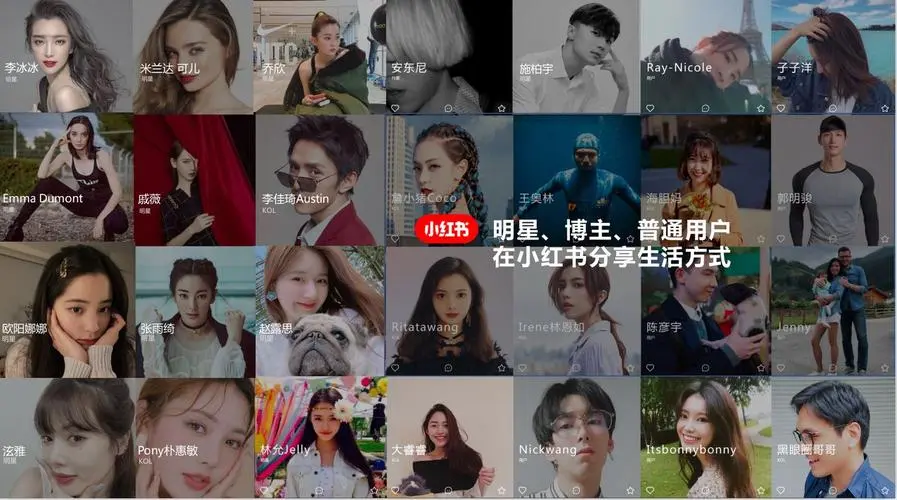
Step 4: Use Platforms to Source Chinese Influencers
Being familiar with the most popular platforms in the process of searching for Chinese influencers is essential. Some of them are:
Pugongying
Xiaohongshu is a Chinese application that combines elements of e-commerce, user-generated content, and product reviews, functioning as a social network. Advertising on Xiaohongshu is also highly significant for brands looking to expand their reach.
One of its key tools is Pugongying, a platform created by Xiaohongshu where brands can collaborate with Xiaohongshu influencers to promote their products and services through images, text, or videos.
To access the platform, a company must first be registered in China. Once registered, brands can send proposals directly to the influencers, who must accept the collaboration to establish communication and proceed with the campaign.
Weirenwu
Weirenwu is the official online advertising platform for Chinese influencers on the Sina Weibo social network. It features influencers in various areas such as comedy, gastronomy, entertainment, live streams, among others.
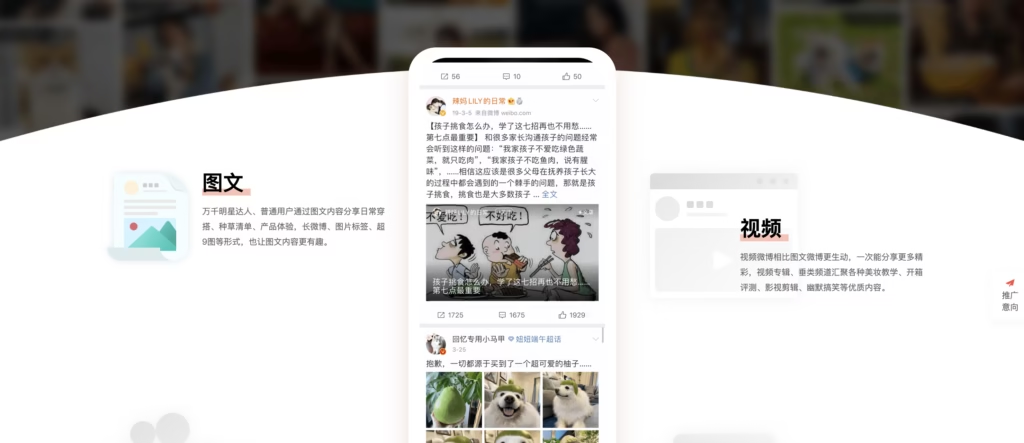
Xingtu
Xingtu is the official platform for collaborating with Chinese influencers on major social networks like Douyin, Xigua, and Toutiao. It serves as a centralized tool for brands to connect with influencers, manage campaigns, and access valuable performance data. As a type of software for influencer management in China, Xingtu is specifically designed to support platform-certified KOL and KOC collaborations within the Douyin ecosystem.
To access Xingtu, businesses must go through a multi-stage registration process, which includes verifying their information and obtaining approval. Additionally, it is mandatory for companies to be registered in China to gain access to the platform’s features and data. This requirement ensures compliance with Chinese regulations and allows brands to utilize Xingtu’s comprehensive analytics and influencer resources effectively.
However, collaborations through the platform tend to be more expensive, as Xingtu charges a percentage of the fees, and most influencers work with agencies that manage their collaborations, adding an additional agency fee. While this method can streamline processes for some brands, there are more direct collaboration options available. We offer direct contact with influencers, bypassing agencies and providing a more cost-effective solution for brands looking to work with influencers efficiently.
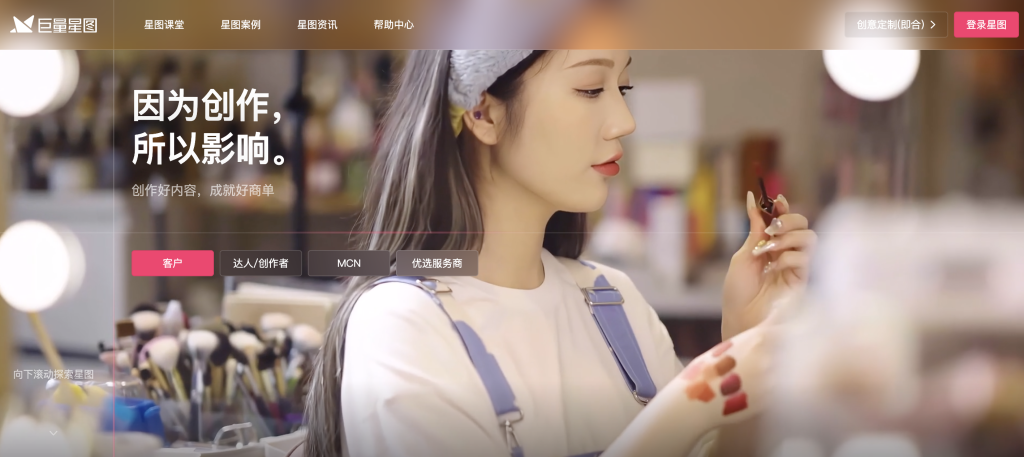
Kuaishou
Collaboration with influencers on Kuaishou can be crucial, as it is a social network that has been experiencing dizzying growth in recent years, plus it is the only social network that does not exclude anyone, so people from tier 3 or 4 cities or rural areas, which are the most interested in shopping, can see your products.
It is important to note that all collaboration platforms with Chinese influencers have as a main and mandatory requirement to have a company registered in China, in addition to paying taxes and a percentage of commission charged by the platform itself.
Any platform for collaboration with influencers in China requires having a registered company in China, in addition to paying taxes and a commission percentage
Another extremely important aspect is that, despite using these platforms, it is necessary to carry out an exhaustive study of the influencer and analyze the data of their videos, since most social media accounts have a considerable amount of fake followers.
Our agency specializing in collaborations with Chinese influencers has a large and solid database of high quality Chinese influencers. Our team has made a thorough selection and conducted successful collaborations with various brands.
We are committed to connecting brands with the right influencers to ensure strategic and effective collaborations. You can count on us to find the perfect Chinese influencers to drive your brand’s success in the Chinese market.
2.5 Other relevant factors
Engaging directly with quality Chinese influencers can be tricky on the platforms we have seen, as they are open to almost all users who call themselves influencers. Also, competition in the Chinese market is stiff, and finding the right Chinese influencer can take time and money.
However, we are here to help you find the KOLs that fit your brand. We specialize in Chinese influencers and have a comprehensive and reputable database, which we have used in the past to assist other clients. If you would like more information about our services, you can contact us directly.
4. How Many Chinese Influencers Do You Need to Collaborate with?
Brands that collaborate with several Chinese influencers are more likely to increase their online visibility. However, this depends on the available budget, which makes it very necessary to invest wisely, especially if the budget is limited.
In addition, it is important to promote and optimize posts. It is not the breadth of the campaign that matters, but the quality of the pre-planned strategy.
5. How Much Does Influencer Marketing Cost in China?
In terms of budget, collaborations with Chinese influencers who have less than 500,000 followers can range from €1,300 to €3,500 per influencer, while for those with more than 500,000 followers, costs start from €3,500 upwards
6. How to Measure ROI in Chinese Influencer Marketing Campaigns
Measuring the return on investment (ROI) in influencer marketing in China goes beyond likes and views — it’s about tracking how influencer-driven content converts into tangible business results.
To evaluate performance effectively, brands should combine engagement metrics, traffic data, and sales conversions from e-commerce integrations.
1. Engagement Metrics
Start by tracking interactions such as likes, comments, shares, and saves.
These indicate how well the content resonates with the audience and whether your message aligns with local interests.
2. Reach and Visibility
Analyse reach, impressions, and follower growth to assess overall campaign exposure.
High reach on platforms like Douyin or Xiaohongshu often translates to improved brand recognition, especially when content is re-shared or featured on trending feeds.
3. Conversion and Sales Impact
The strongest ROI indicator is direct conversion data.
China’s influencer ecosystem makes this easier thanks to e-commerce integrations — for example, Douyin Shops or WeChat Mini Programs let users buy products directly from influencer content.
Tracking sales uplift through affiliate links, discount codes, or unique QR codes provides measurable ROI.
4. Traffic Analytics
Use analytics tools such as WeChat backend insights or Douyin’s data dashboards to track referral traffic.
Monitoring click-through rates (CTR) from influencer posts to your product pages gives clear visibility into campaign efficiency.
5. Long-Term Brand Lift
Beyond immediate sales, influencer marketing also boosts brand awareness, trust, and sentiment.
These are measured through surveys, social listening, and repeat engagement — key indicators of sustained ROI in China’s competitive digital landscape.

Conclusion: Key Takeaways on Influencer Marketing in China
Chinese influencers are especially relevant for brands looking to connect with local consumers. With the rapid growth of e-commerce in China and the increasing purchasing power of the middle class, Chinese influencers have become an important tool for brands to promote their products and services.
If you need help with your marketing strategies in China, InfluChina can help you deploy the most efficient digital marketing strategies for the Chinese market. For more information email hello@influchina.com or check our services.
FAQ
FAQ on Influencer Marketing in China
What is the difference between KOL and KOC in China?
KOLs (Key Opinion Leaders) are professional influencers with large followings who shape public opinion and drive awareness. KOCs (Key Opinion Consumers) are everyday users who share authentic reviews and recommendations within smaller circles. Both play key roles in China’s influencer ecosystem — KOLs for reach, KOCs for trust.
Why is influencer marketing so effective in China?
Because Chinese consumers place strong trust in peer recommendations, influencer marketing feels more authentic than traditional ads. Around 74% of Chinese buyers make purchase decisions based on influencer content.
How can foreign brands find Chinese influencers?
Foreign brands can connect with Chinese influencers through official collaboration platforms such as Xingtu, Weirenwu, or Pugongying, or work with a local agency like InfluChina, which simplifies vetting, contracts, and payments.
How much does influencer marketing cost in China?
Costs vary depending on follower count and platform. Nano and micro KOLs (1K–100K followers) typically charge between €500–€3,000 per campaign, while macro influencers (500K+) can start from €3,500 upwards.
How do brands measure ROI for influencer campaigns in China?
Key performance indicators include engagement rate, follower growth, click-throughs, sales conversions, and livestream performance. Platforms like Douyin and Xiaohongshu provide built-in analytics to track conversions from influencer posts.

